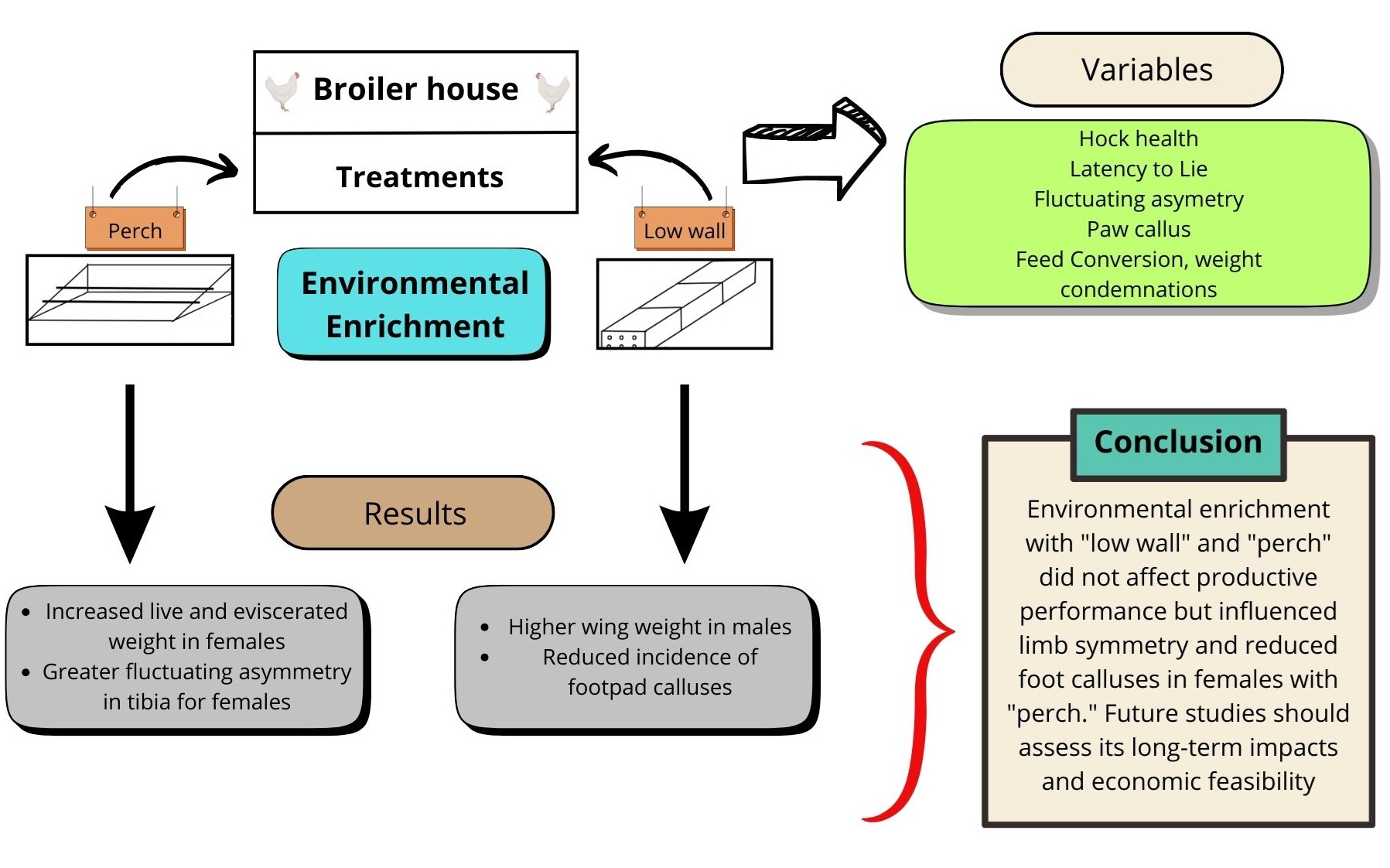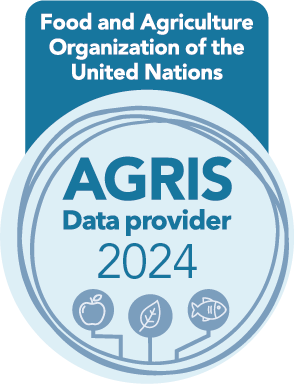Environmental enrichment using low walls and perches improves broiler welfare, without compromising productivity
DOI:
https://doi.org/10.17268/sci.agropecu.2025.015Palabras clave:
Animal welfare, joint injuries, locomotor problems, zootechnical performanceResumen
The study evaluated the impact of different environmental enrichment strategies on the performance and welfare of commercially raised broilers. The research, conducted in Paraná, Brazil, involved 690 birds allocated to three types of environments: control, with a low wall, and with a perch. The performance of the birds was monitored through indicators such as feed conversion, live weight (plucked and eviscerated), and cut yields (wing, thigh, drumstick, breast, and back weight). There were no significant differences in feed conversion and yields between the environments, except for wing weight, which was higher in environments with a perch for males. Females raised in an environment with a low wall showed higher live and eviscerated weight, while thigh weight was lower in environments with a perch. Welfare variables, such as Latency to Lie and Fluctuating Asymmetry, showed no significant differences between the environments. However, females in the control and low wall environments had a higher incidence of calluses on their feet compared to those in the perch environment. Joint injuries (Hock Health) did not show significant differences between the types of enrichment. These results suggest that, although environmental enrichment may benefit some aspects of welfare, its impact on broiler performance and joint health needs to be better understood, particularly in relation to the long-term effects of different enrichment types on locomotor health, muscle development, and the prevention of joint injuries. Future studies should focus on the physiological mechanisms behind these effects, including the role of enrichment in reducing stress and promoting more natural behaviors that may influence bone density and joint function.
Citas
Aksit, M., Yardim, Z. K., & Yalcin, S. (2017). Environmental enrichment influences on broiler performance and meat quality: Effect of light source and providing perches. European Poultry Science, 81. https://doi.org/10.1399/eps.2017.182
Bach, M. H., Tahamtani, F. M., Pedersen, I. J., & Riber, A.B. (2019). Effects of environmental complexity on behaviour in fast-growing broiler chickens. Applied Animal Behaviour Science, 219, 104840. https://doi.org/10.1016/j.applanim.2019.104840
Bailie, C. L., Baxter, M., & O'Connell, N. E. (2018). Exploring perch provision options for commercial broiler chickens. Applied Animal Behavior Science, 200, 114-122. https://doi.org/10.1016/j.applanim.2017.12.007
Bailie, C. L., & O'Connell, N. E. (2015). The influence of providing perches and string on activity levels, fearfulness and leg health in commercial broiler chickens. Animal, 9, 660-668. https://doi.org/10.1017/S1751731114002821
Bailie, C. L., & O'Connell, N. E. (2014). The effect of level of straw bale provision on the behavior and leg health of commercial broiler chickens. Animal, 8, 1715-1721. https://doi.org/10.1017/S1751731114001529
Bizeray, D., Estevez, I., Leterrier, C., & Faure, J. M. (2002). Effects of increasing environmental complexity on the physical activity of broiler chickens. Applied Animal Behavior Science, 79, 27-41. https://doi.org/10.1016/S0168-1591(02)00083-7
Brasil. (2024). Resolução Normativa CONCEA n. 69, de 30 de outubro de 2024. Dispõe sobre a realocação de animais em atividades de ensino ou pesquisa científica. https://www.in.gov.br/en/web/dou/-/resolucao-n-69-de-30-de-outubro-de-2024-593097421
Cobb-Vantress. Suplemento: Desempenho e Nutrição para Frangos de Corte Cobb 500®. (2013). http://www.cobb-vantress.com/languages/guidefiles/793a16cc-5812-4030-9436-1e5da177064f_pt.pdf
Dinev, I., Denev, S., Vashin, I., Kanakov, D., & Rusenova, N. (2019). Pathomorphological investigations on the prevalence of contract dermatitis lesions in broiler chickens. Journal of Applied Animal Research, 47, 129-134. https://doi.org/10.1080/09712119. 2019.1584105
Dixon, L. M. (2020). Slow and steady wins the race: the behavior and welfare of commercial faster growing broiler breeds compared to a commercial slower growing breed. PLoS One, 15(4), e0231006. https://doi.org/10.1371/journal.pone.0231006
Dukic-Stojcic, M., & Bessei. W. (2011). The effect of weight load on the legs of broilers behaviour. Biotechnology in Animal Husbandry, 27, 1667-1671. https://doi.org/10.1016/j.psj.2020.12.063
Elsayed, R. A., Mohammed, A. S., Abou-Elnage, A. F., & Abou-Ismail, U. A. (2024). Effect of different types of environmental enrichment on behavior, performance, welfare, carcass characteristics and lipid profile of broiler chickens. Mansoura Veterinary Medical Journal, 25(1), 2. https://doi.org/10.35943/2682-2512.1225
Forslind, S., Blokhuis, H. J., & Riber, A. B. (2021). Disturbance of resting behavior of broilers under diferent environmental conditions. Applied Animal Behavior Science, 242, 105425. https://doi.org/10.1016/j.applanim.2021.105425
Ghani, A., Mehmood, S., Hussnain, F., & Saima (2025). Effects of different environmental enrichment tools to improve behavior, welfare, and growth performance of broiler chickens. Tropical Animal Health and Production, 57(33). https://doi.org/10.1007/s11250-025-04292-z
Jong, I. C., Bos, B., Van Harn, P., Mostert, P., & Beest, D. (2022). Differences and variation in welfare performance of broiler flocks in three production systems. Poultry Science, 101(7), 101933. https://doi.org/10.1016/j.psj.2022.101933
Kjaer, J. B., Su, G., Nielsen, B. L., & Sørensen, P. (2006). Foot pad dermatitis and hock burn in broiler chickens and degree of inheritance. Poultry Science, 85(8), 1342-1348. https://doi.org/10.1093/ps/85.8.1342
Kotloski, R. J., & Sutula, T. P. (2015). Environmental enrichment: Evidence for an unexpected therapeutic influence. Experimental Neurology, 264, 121-126. https://doi.org/10.1016/j.expneurol.2014.11.012
Marchewka. J., Watanabe, T. T. N., Ferrante, V., & Estevez, I. (2013). Welfare assessment in broiler farms: Transect walks versus individual scoring. Poultry Science, 92, 2588-2599. https://doi.org/10.3382/ps.2013-03229
Martins, B., Martins, M., Mendes, A., Fernandes, B., & Aguiar, E. (2016). Footpad dermatitis in broilers: differences between strains and gender. Brazilian Journal of Poultry Science, 18, 461-466. https://doi.org/10.1590/1806-9061-2015-0105
Mendes, A. A. (1990). Effect of genetic, nutritional and environmental factors on carcass yield of broiler chickens. PhD thesis, Faculty of Veterinary Medicine and Animal Science, São Paulo State University, Botucatu, SP.
Moller, A. P. (1999). Asymmetry as a predictor of growth, fecundity and survival. Ecology Letters, 2, 149-156. https://doi.org/10.1046/j.1461-0248.1999.00059.x
Oh, J. Y., Kang, M. S., An, B. K., Song, E. A., Kwon, J. H., & Kwon, Y. K. (2010). Occurrence of purulent arthritis broilers vertically infected with Salmonella enterica serovar Enteritidis in Korea. Poultry Science, 89, 2116-2122. https://doi.org/10.3382/ps.2010-00918
Ohara, A., Oyakawa, C., Yoshihara, Y., Ninomiya, S., & Sato, S. (2015). Effect of environmental enrichment on the behavior and welfare of Japanese broilers at a commercial farm. The Journal of Poultry Science, 52, 323-330. https://doi.org/10.2141/jpsa.0150034
Oliveira, A. A., Andrade, M. A., Armendaris, P. M., & Bueno, P. H. S. (2016). Main causes of condemnation to the slaughter of poultry in slaughterhouses registered in the Brazilian Federal Inspection Service between 2006 and 2011. Ciência Animal Brasileira, 17(1), 79-89. https://doi.org/10.1590/1089-6891v17i123020
Pagazaurtundua, A., & Warriss, P. D. (2006). Measurements of footpad dermatitis in broiler chickens at processing plants. Veterinary Record, 158, 679-682. https://doi.org/10.1136/vr.158.20.679
Pedersen, I. J., Tahamtani, F. M., Forkman, B., Young, J. F., Pulsen, H. D., & Riber, A. B. (2020). Effects of environmental enrichment on health and bone characteristics of fast growing broiler chickens. Poultry Science, 99, 1946-1955. https://doi.org/10.1016/j.psj.2019.11.061
Riber, A. B., Van de Weerd, H. A., De Jong, I. C., & Steenfeldt, S. (2018). Review of environmental enrichment for broiler chickens. Poultry Science, 97, 378-396. https://doi.org/10.3382/ps/pex344
Ruiz-Feria, C. A., Arroyo-Villegas, J. J., Pro-Martinez, A., Bautista-Ortega, J., Cortes-Cuevas, A., Narciso-Gaytan, C., Hernandez-Cazares, A., & Gallegos-Sanchez, J. (2014). Effects of distance and barriers between resources on bone and tendon strength and productive performance of broiler chickens. Poultry Science, 93, 1608-1617. https://doi.org/10.3382/ps.2013-03421
Sans, E. C. O., Federici, J. F., Hammerschmidt, J., Clemente, H. C., Dahlke, F., & Molento, C. F. M. (2014). Environmental enrichment on the welfare of industrial broiler chickens. Rural Science, 44, 1867-1873. https://doi.org/10.1590/0103-8478cr20120504
Santos, M. N., Widowski, T. M., Kiarie, E. G., Guerin, M. T., Edwards, A. M, & Torrey, S. (2022). In pursuit of a better broiler: walking ability and incidence of contact dermatitis in conventional and slower growing strains of broiler chickens. Poultry Science, 101(4), 101768. https://doi.org/10.1016/j.psj.2022.101768
Silva, M. I. L., Almeida Paz, I. C. L., Chaves, G. H. C., Almeida, I. C. L., Ouros, C. C., Souza, S. R. L., Milbradt, E. L., Caldara, F. R., Satin, A. J. G., Costa, G. A., & Glavina, A. S. G. (2021). Behaviour and animal welfare indicators of broiler chickens housed in an enriched environment. PLoS One, 16, 1-16. https://doi.org/10.1371/journal.pone.0256963
Simsek, U. G., Dalkilic, B., Ciftci, M., Cerci, I. H., & Bahsi, M. (2009). Effects of enriched housing design on broiler performance, welfare, chicken meat composition and serum cholesterol. Acta Veterinaria Brno, 78, 67-74. https://doi.org/10.2754/avb200978010067
Singh, M., Lim, A. J., Muir, W. I., & Groves, P. J. (2021). Comparison of performance and carcass composition of a novel slow-growing crossbred broiler with fast-growing broiler for chicken meat in Australia. Poultry Science, 100, 100966. https://doi.org/10.1016/j.psj.2020.12.063
Škrbić, Z., Pavlovsky, Z., Lukić, M., & Petričević, V. (2015). Incidence of footpad dermatitis and hock burns in broilers as affected by genotype, lighting program and litter type. Annals of Animal Science, 15, 433-445. https://doi.org/10.1515/aoas-2015-0005
Tahamtani, F. M., Pedersen, I. J., Toinon, C., & Riber, A. B. (2018). Effects of environmental complexity on fearfulness and learning ability in fast growing broiler chickens. Applied Animal Behavior Science, 207, 49-56. https://doi.org/10.1016/j.applanim.2018.04.005
Taira, K., Nagai, T., Obi, T., & Takase, K. (2014). Effect of litter moisture on the development of footpad dermatitis in broiler chickens. The Journal of Veterinary Medical Science, 76(4), 583-586. https://doi.org/10.1292/jvms.13-0321
Tickle, P. G., Hutchinson, J. R., & Codd, J. R. (2018). Energy allocation and behavior in the growing broiler chicken. Scientific Reports, 8, 1-13. https://doi.org/10.1038/s41598-018-22604-2
Van De Weerd, H. A., Keatinge, R., & Roderick, S. (2019). A review of key health-related welfare issues in organic poultry production. World's Poultry Science Journal, 65, 649-684. https://doi.org/10.1017/S0043933909000464
Vas, J., BenSassi, N., Vasdal, G., & Newberry, R. C. (2023). Better welfare for broiler chickens given more types of environmental enrichments and more space to enjoy them. Applied Animal Behaviour Science, 261, 105901. https://doi.org/10.1016/j.applanim.2023.105901
Vizzier-Thaxton, Y., Christensen, K. D., Mench, J. A., Rumley, E. R., Daugherty, C., Feinberg, B., Parker, M., Siegel, P., & Scanes, C. G. (2016). Symposium: Animal welfare challenges for today and tomorrow. Poultry Science, 95, 2198-2207. https://doi.org/10.3382/ps/pew099
Weeks, C. A., Danbury, T. D., Davies, H. C., Hunt, P., & Kestin, S. C. (2000). The behavior of broiler chickens and its modification by lameness. Applied Animal Behavior Science, 67, 111-125. https://doi.org/10.1016/S0168-1591(99)00102-1
Weimer, S. L., Wideman, R. F., Scanes, C. G., Mauromoustakos, A., Christensen, K. D., & Vizzier-Thaxton, Y. (2020). Broiler stress responses to light intensity, flooring type, and leg weakness as assessed by heterophil-to-lymphocyte ratios, serum corticosterone, infrared thermography, and latency to lie. Poultry Science, 99(7), 3301-3311. https://doi.org/10.1016/j.psj.2020.03.028
Zahoor, M. S., Ahamd, S., Usman, M., Dawood, M., Sabrout, K. E. L., Hashmi, S. G. M. D., Khan, E. U., Hussain, M., Maqsood, M. A., & Latif, H. R. A. (2022). Effects of mirror and coloured balls as environmental enrichment tools on performance, welfare and meat quality traits of commercial broiler. Tropical Animal Health and Production, 54(2), 151. https://doi.org/10.1007/s11250-022-03155-1

Descargas
Publicado
Cómo citar
Número
Sección
Licencia
Derechos de autor 2025 Scientia Agropecuaria

Esta obra está bajo una licencia internacional Creative Commons Atribución-NoComercial 4.0.
Los autores que publican en esta revista aceptan los siguientes términos:
a. Los autores conservan los derechos de autor y conceden a la revista el derecho publicación, simultáneamente licenciada bajo una licencia de Creative Commons que permite a otros compartir el trabajo, pero citando la publicación inicial en esta revista.
b. Los autores pueden celebrar acuerdos contractuales adicionales separados para la distribución no exclusiva de la versión publicada de la obra de la revista (por ejemplo, publicarla en un repositorio institucional o publicarla en un libro), pero citando la publicación inicial en esta revista.
c. Se permite y anima a los autores a publicar su trabajo en línea (por ejemplo, en repositorios institucionales o en su sitio web) antes y durante el proceso de presentación, ya que puede conducir a intercambios productivos, así como una mayor citación del trabajo publicado (ver efecto del acceso abierto).




